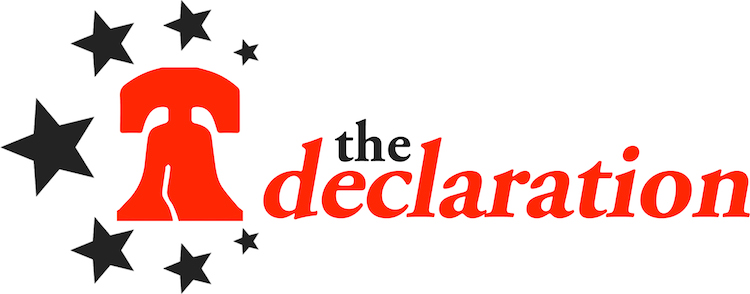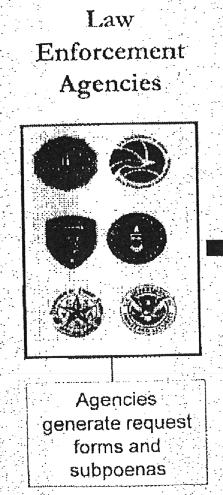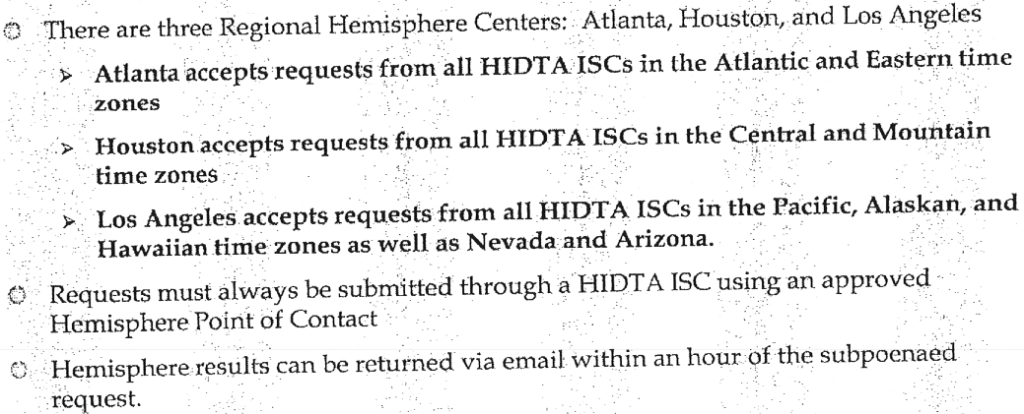By Dustin Slaughter
Federal, state, and local police, with the assistance of phone company employees embedded within DEA narcotics intelligence units, are utilizing an unclassified but “law enforcement sensitive” program, known as Hemisphere, which provides nearly unfettered access to an enormous database containing call records of all telephone calls passing through phone company switches likely owned by AT&T, according to a partially-redacted 24-slide presentation obtained by The Declaration.
The program is part of counterdrug operations within the Philadelphia-Camden High Intensity Drug Trafficking Area (PC-HIDTA), which encompasses Philadelphia, Delaware & Chester Counties as well as Camden County, NJ.
Hemisphere is funded by the White House Office of National Drug Control Policy (ONDCP) as part of the administration’s High Intensity Drug Trafficking Area initiative, with AT&T receiving an undisclosed amount of federal dollars to add nearly five billion calls per day, nationwide, to the Hemisphere database, and to assist authorities in maintaining the program’s secrecy from an investigation’s launch up to and including actual trials.
Hemisphere differs from – and far exceeds in scope – the National Security Agency’s phone record collection program, called Section 215, as the NSA maintains its own database and stores records for just five years. The Hemisphere database stores call detail records (CDR) dating as far back as 1987.
It is not known whether other carriers including Verizon, T-Mobile, and Sprint, have a similar arrangement with DEA to allow access to their call switches. What is clear: all calls from those carriers which pass through AT&T switches are immediately entered into the database.
The New York Times first revealed the existence of Hemisphere late last year, when an activist from Washington state was accidentally given slides through a public records request indicating the program was being used by law enforcement agencies on the West Coast. The New York Times article indicates that “Hemisphere West” launched in 2007.
The slides obtained by The Declaration from the Obama administration, while undated, suggest the program predates 2007, however, because Hemisphere West cites the program’s ability to access 20 years worth of call data, while The Declaration‘s version cites just 10 years worth of access. This east coast version presumably now has access to at least 20 years of data.
A Drug Enforcement Administration spokesperson did not respond to a list of emailed questions including: how long Hemisphere has operated in Southeastern PA; how many local and state law enforcement requests have been submitted since the start of the program; Hemisphere “success stories”; what privacy safeguards and auditing procedures, if any, are in place. DEA also did not respond to a phone request for comment.
This latest document also suggests that the DEA, state, and local police aren’t the only agencies that use Hemisphere in Southeastern Pennsylvania.
One slide indicates that the Department of Homeland Security, U.S. Marshals Service, FBI, and possibly the U.S. Coast Guard may have access to the database.
Just as the slides published by The New York Times included Hemisphere “success stories”, so does this latest batch; one titled “To Catch a Predator” seems to indicate a non-drug related operation. The other, “New York State of Mind”, may be alluding to a massive prescription drug bust in New York last year.
How Hemisphere Operates: Painstaking Secrecy from Investigation’s Start through Trial
The process begins when a state-level or local investigator, for example, fills out a request form and submits it with an agency-issued subpoena (also known as an administrative subpoena) to the Philadelphia-Camden “Investigative Support Center” (ISC).

Hemisphere manual instructs first-time requesters to contact the Philly-Camden HIDTA intelligence analyst.
The ISC point person is the intermediary between the investigator and phone company employee, or “Hemisphere analyst”.
Once the required documentation is vetted for sufficient details by the ISC, it is then forwarded to a regional Hemisphere center. For the Philadelphia-Camden HIDTA, this center is located in Atlanta, GA.
Two additional centers – one in Houston and another in Los Angeles – handle requests for other parts of the country.
Hemisphere analysts in the Atlanta center will then search Hemisphere’s enormous database, pull up the records, and then return results directly to the requesting investigator through email in as little as an hour.
The unilateral power given to law enforcement agencies by Hemisphere’s secrecy is matched only by the currently unknown software it uses, allowing investigators to start with one target number and expand to include additional “possibly significant numbers”, immediately widening the collection of call records. The document also touts Hemisphere’s ability to locate dropped (“burner”) phones, through an algorithm, by analyzing “the calling pattern of a previous target phone to find the new number.”
Additionally, state and local investigators are required to perform what is called “parallel subpoenaing” – a keystone of the DEA’s recently revealed and legally problematic “parallel construction” policy involving its Special Operations Division – in order to “maintain the integrity” of Hemisphere.
With each request for call records submitted to Hemisphere analysts, investigators must also subpoena the call carrier after the Hemisphere records are obtained, thus “walling off” the program by creating a seemingly innocuous paper trail for investigators and any subsequent trial.
The document makes explicit:
Hemisphere Exists in Potentially Legal Grey Area
These call detail records are obtained with no judicial oversight; investigators need only submit a Hemisphere request form and a subpoena issued from a law enforcement agency, known as an administrative subpoena.
Jeffrey Vagle, a former associate in Pepper Hamilton’s Privacy, Security and Data Protection Group and now executive director of Penn Law’s Center for Technology, Innovation & Competition, believes Hemisphere is operating in a legal grey area.
Vagle thinks Hemisphere would likely withstand “the third party doctrine”, a legal threshold created in the wake of Smith v. Maryland, a landmark 1979 case which upheld that data willingly given over to a phone company – such as dialing a phone number – invalidates an individual’s Fourth Amendment protection against unreasonable, warrantless search and seizure.
He is troubled by the need for the program’s secrecy, however.
“A program like this should be able to withstand legal scrutiny. And we don’t do that by keeping it secret. Judges handle secret or sensitive information all the time. There’s ways to do that, where the judge can at least take a look at what’s going on and make an informed decision without informing the world about it.
Former federal prosecutor and current Columbia law professor Daniel C. Richman told the New York Times last year that Hemisphere merely “streamlines” the “bread-and-butter” practice of subpoenaing a suspect’s phone records, but he added that the program may have one Fourth Amendment problem: namely whether mere access to such a massive amount of data is “reasonable”.
Others in the legal community, such as Electronic Frontier Foundation (EFF) staff attorney Hanni Fakhoury, echo some of that concern, but Fakhoury raises another question: who actually manages Hemisphere’s massive database. Is it AT&T or the government?
In an email interview with The Declaration, he wrote:
“While the slides indicate the government should use a subpoena to get this info initially, there’s an interesting question about whether the government is collecting or ‘seizing’ this data before it even is making a request. It’s not entirely clear who maintains or stores these records.”
Perhaps a clearer Constitutional problem arises when the use of Hemisphere’s parallel subpoenaing – or what the EFF calls “intelligence laundering” – meets the Fifth Amendment, which contains a “right to due process” clause. This clause, reaffirmed in Brady v. Maryland, requires the government to disclose “material evidence”, or facts that could change the course and outcome of a trial.
Here’s where the Fourth and Fifth Amendments coalesce and run up against a program like Hemisphere: when the government hides sources and methods – “evidence” for purposes of the Fifth Amendment – from a defendant and their legal counsel, this deprives a defendant the right to challenge evidence used against them, and to question the veracity of affidavits served with a search warrant or wiretap request – which is where the Fourth Amendment enters.
Hemisphere’s controversial nature has drawn the attention of the Justice Department’s Office of Inspector General (OIG), which recently launched a review of the program.
According to OIG’s website, this ongoing review is examining “the legal authority for the acquisition or use of these data collections; the existence and effectiveness of any policies and procedural safeguards established with respect to the collection, use, and retention of the data; [and] the creation, dissemination, and usefulness of any products generated from the data.”
It’s not clear how the report will impact the program or the legal system, but challenges to Hemisphere have already started in court.
Last year, the Electronic Frontier Foundation became the first legal advocacy organization to push back against Hemisphere. While their amicus brief was ultimately not successful, however, Fakhoury believes there are ways attorneys can better represent defendants and strengthen due process:
“In any case where the government has used phone records or CDRs [call detail records] they obtained via subpoena, or obtained location information via cell site location data or a cell phone’s GPS, a defense attorney should request whether Hemisphere was used to develop leads or run data analysis. If there are specific orders or warrants that reference ‘confidential sources,’ then defense attorneys should be making discovery requests and notifying the court that references to ‘confidential sources’ could potentially be the Hemisphere program.”
The Declaration will continue our investigative reporting on this and other issues. Sign up for email updates and follow us on Twitter and Facebook.









100% you should use PDFy instead of scribd for document hosting. Scribd is not for document hosting it’s for reading of ebooks and things. It uses DRM to restrict free access to their materials. Here’s a copy of the PDF on PDFy, and a link to a founder stating the purpose of Scribd.
https://pdf.yt/d/L8LI2Gf8n2wQivsN
and
https://news.ycombinator.com/item?id=8035319
PDFy has an easy embed interface, download button right on the embed/site, and automatic archiving in the Internet Archive for all documents uploaded as Public.
Thanks!
LikeLike
Thanks for the heads up!
LikeLike
[…] « Federal, state, and local police, with the assistance of phone company employees embedded within DEA narcotics intelligence units, are utilizing an unclassified but “law enforcement sensitive” program, known as Hemisphere, which provides nearly unfettered access to an enormous database containing call records of all telephone calls passing through phone company switches likely owned by AT&T, according to a partially-redacted 24-slide presentation obtained by The Declaration. […] Hemisphere differs from – and far exceeds in scope – the National Security Agency’s phone record collection program, called Section 215, as the NSA maintains its own database and stores records for just five years. The Hemisphere database stores call detail records (CDR) dating as far back as 1987. » […]
LikeLike
“Legal gray area”? WTF? Presumably this ‘gray area’ exists in some 4th Amendment-free alternative universe.
/Scribd does suck. No pdf downloads = crap.
LikeLike
[…] week, Dustin Slaughter published a story using a new deck of slides on the Hemisphere program, the Drug Czar program that permits […]
LikeLike
[…] 24-slide presentation obtained by The Declaration from the Drug Enforcement Administration (DEA) and Office of National Drug Control Policy (ONDCP) […]
LikeLike
[…] assessment from TruthOut, crossposted from Philadelphia’s independent outlet, The Declaration, about a call intercept program that is much broader and more invasive than anything that the […]
LikeLike
[…] exposed how the Drug Enforcement Administration, in partnership with the White House, is using a highly-sensitive, Constitutionally-questionable telephone record collection program named… in our […]
LikeLike
[…] for the first time the existence of a program known as “Hemisphere.” which allows the DEA and local law enforcement to obtain call records from AT&T. As government presentations about the program repeatedly make […]
LikeLike
[…] for the first time the existence of a program known as “Hemisphere.” which allows the DEA and local law enforcement to obtain call records from AT&T. As government presentations about the program repeatedly make […]
LikeLike
[…] for the first time the existence of a program known as “Hemisphere.” which allows the DEA and local law enforcement to obtain call records from AT&T. As government presentations about the program repeatedly make […]
LikeLike
[…] for the first time the existence of a program known as “Hemisphere.” which allows the DEA and local law enforcement to obtain call records from AT&T. As government presentations about the program repeatedly make […]
LikeLike
[…] for the first time the existence of a program known as “Hemisphere.” which allows the DEA and local law enforcement to obtain call records from AT&T. As government presentations about the program repeatedly make […]
LikeLike
[…] first time the existence of a program known as “Hemisphere.” which allows the DEA and local law enforcement to obtain call records from AT&T. As government presentations about the program repeatedly make […]
LikeLike
[…] for the first time the existence of a program known as “Hemisphere.” which allows the DEA and local law enforcement to obtain call records from AT&T. As government presentations about the program repeatedly make […]
LikeLike
[…] for the first time the existence of a program known as “Hemisphere.” which allows the DEA and local law enforcement to obtain call records from AT&T. As government presentations about the program repeatedly make […]
LikeLike
[…] and the basis used to make those accuracy claims (for one incarnation of the Hemisphere dragnet, DEA was claiming 94% accuracy, based of 10 years of data and, apparently, multiple providers). And this points to the […]
LikeLike
[…] for the first time the existence of a program known as “Hemisphere.” which allows the DEA and local law enforcement to obtain call records from AT&T. As government presentations about the program repeatedly make […]
LikeLike